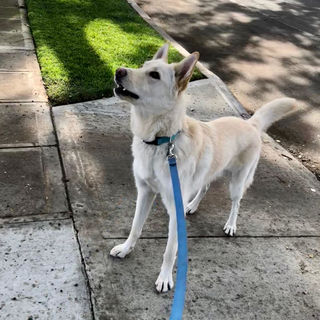Behaviorism
A Psychoanalyst Discovers the Value of Behaviorism
The case of the fearful dog.
Posted July 23, 2019

After a hiatus, I am resurfacing to tell you about a new project that I have been working on. Believe it or not, this psychoanalyst has been on a mission to learn about behaviorism. I have been learning about Pavlov’s classical conditioning and B. F. Skinner’s operant conditioning in the context of… wait for it… dog training!
Recently, my family rescued an adolescent German Shepherd mix, Lucky. He is a sweet, sensitive boy with a loving, joyful spirit. Over the first few months, we discovered that he had a lot of strengths and a few worrisome weaknesses.
He was well mannered in the house, quick to learn the routine with no destructive behaviors common among young and rescued dogs. He got along well with our other dog and the whole family. That being said, he had a lot of fears in the outside world. He was fearful of strangers, other dogs, car rides, bicyclists, skateboards, and wheelchairs, as well as being handled by the vet or for nail trims. While these are common fears for dogs, Lucky’s level of fearfulness was pretty high. When frightened, he would bark and lunge—which was scary for everyone involved!
This is where my education about behaviorism began. I found a topnotch dog trainer and began to do some research. My favorite books are listed in the reference section below.

It turns out that the model of choice in dog training is B. F. Skinner’s operant conditioning since the brains of dogs are particularly suited to the ABC’s of instrumental learning. In the old days, dog trainers mostly relied on two of Skinner’s four principles: positive punishment and negative reinforcement. Fortunately, modern dog training has shifted from this aversive training approach and now utilizes Skinner’s other two principles: positive reinforcement (mostly) and negative punishment (selectively).
In the new model, dogs are trained to do something that you desire in order to earn something they desire. As the American Kennel Club puts it, the dog obeys with “the utmost willingness and enjoyment” rather than fear of correction.
It was fun to work with Lucky on his obedience skills using this model. He easily learned the basics: sit, down, stay, come when called, loose-leash walking, and leave it. He also learned quite a few tricks: shake, high five, spin, go to sleep, roll over, and say your prayers. He was motivated to learn for the rewards of chicken morsels and the joy of hearing an enthusiastic “Good boy” from me. To my delight, our bond grew as well. Operant conditioning: success.
The greater challenge was addressing Lucky’s fearfulness. We began with Patricia McConnell’s classic, Feisty Fido: Help for the Leash-Reactive Dog. Dr. McConnell’s approach relies mostly on Skinner’s operant conditioning with a small dose of Pavlov’s classical conditioning. When exposed to the feared stimulus (a person or another dog), the student dog is taught to look at the handler with a cue like “watch.” When the student dog looks, a treat reward is delivered. This ABC process reinforces the dog for looking away from the trigger and looking at the handler, which helps in reducing reactivity.
With repetition, the cue no longer becomes necessary as the dog develops an “autowatch”; he sees the trigger and automatically looks at the handler, who then delivers the treat. This is where Pavlov’s classical conditioning works its magic. Over time, from the dog’s perspective, the sight of the trigger itself is associated with the reinforcer (i.e., scary dog = tasty treat). Technically, this would be called classical counter-conditioning, because we are working with an undesirable stimulus, but you get the idea.
While Lucky’s solid autowatch helped make neighborhood walks less stressful, this approach did not do the whole job. He was still anxious and vigilant when out-and-about. I so wanted to lower his overall level of arousal, so I got some more books and delved deeper. I needed to better understand classical conditioning and counter-conditioning.
The more I studied, the more it clicked that classical conditioning is quite different from operant conditioning. In classical conditioning, the reinforcer is given simply when the stimulus (trigger) is present. It took me a little while to wrap my mind around the fact that the dog doesn’t have to do anything to “earn” the reinforcer. But once I got it, Lucky progressed.
When out on walks, I would mark and treat whenever there was the hint of a scary trigger. A dog barks a block away: mark and treat. A dog is spotted 100 feet away: mark and treat. A man walks out his front door: mark and treat. The beauty of classical counter-conditioning is that Lucky was developing positive associations to scary things when in a much lower state of arousal—he didn’t have to think, perform, obey, or do anything at all to earn the treat. This clearly had a positive effect in decreasing his overall arousal and generalized to multiple settings. Classical counter-conditioning: success.
Lucky’s fearfulness is still a work in progress. We work the behavior modification protocol every day. Sometimes I do a little counter-conditioning when we are especially close to a trigger or utilize operant conditioning to reward him when he has shown good self-control under pressure. Happily, two years later, thanks to the principles of behaviorism, I have a well behaved and much more relaxed dog than I had before.
Through this process, I became a believer in the value of behaviorism—and not just in dog training. I find myself looking for the positive and saying things like, “Good job!” to the people in my life, including my patients. I see more clearly now that behavioral principles are at the foundation of psychoanalysis. Psychoanalysts (along with most other psychotherapists) create an environment in which patients can build positive associations with the process of sharing their fears, pain, and difficulties. I am humbled by the idea that change at this most basic level may have as much therapeutic impact (or maybe even more) than change at the level of insight which we psychoanalysts prize so much.
References
MicConnell, Patricia B. (2002). The Other End of the Leash: Why We Do What We Do Around Dogs. New York: Ballantine Books.
McConnell, Patricia B and London, Karen B. (2003). Feisty Fido: Help for the Leash-Reactive Dog, 2nd Edition. Black Earth, WI: McConnell Publishing.
McConnell, Patricia B. (2007). For the Love of a Dog: Understanding Emotion in You and Your Best Friend. New York: Ballantine Books.
Miller, Pat. (2008). The Power of Positive Dog Training, 2nd Edition. Hoboken, NJ: Howell Bookhouse.
Donaldson, Jean. (1996). The Culture Clash: A Revolutionary New Way of Understanding the Relationship Between Humans and Domestic Dogs. Berkley, CA: James and Kenneth Publishers.
Pryor, Karen. (2009). Reaching the Animal Mind: Clicker Training and What It Teaches Us about All Animals. New York: Scribner.
Stewart, Grisha. (2016). Behavior Adjustment Training 2.0: New Practical Techniques for Fear, Frustration, and Aggression in Dogs. Wenatchee, WA: Dogwise Publishing.




